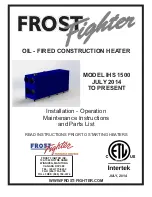
30
PART 6: FIELD WIRING
A. FIELD WIRING COMPLIANCE REQUIREMENTS
ELECTRICAL SHOCK HAZARD – For your safety, to avoid possible electrical shock hazard, turn off
electrical power supply at service entrance panel before making any electrical connections. Failure to do
so can result in severe personal injury or death.
NOTE:
Wiring must be N.E.C. Class 1.
If original wiring as supplied with boiler must be replaced, use only TEW 105
o
C wire or equivalent.
Boiler must be electrically grounded as required by National Electrical Code ANSI/NFPA 70 – latest
edition.
INSTALLATION MUST COMPLY WITH:
1. National Electrical Code and any other national, state, provincial or local codes or regulations.
2. In Canada, CSA C22.1 Canadian Electrical Code Part 1, and any local codes.
B. FIELD WIRING
All the wiring connections made to the heater in the field are done on the field connection board located
on the right side of the cabinet. The cabinet has multiple knockouts available to route field wiring into and
out of the field connection board. The control provides a pump output thermostat and outdoor sensor
inputs to operate the central heating system.
C. LINE VOLTAGE WIRING
1. Connect the normal
incoming power
to the terminals marked as shown in Figure 14. A line voltage
fused disconnect switch may be required to be externally mounted and connected according to local
codes and standards.
2. Connect the
central heating pump
as shown in the terminals marked CH/DHW PUMP (see Figure
14). The connections shown are suitable for a maximum continuous pump draw of 3 amps at 120 volts. If
the pump requires more current or voltage than the 120 volts supplied, an external motor starter will be
required.
3. Please not that the solar pump connectors on the field connection board are not functional at this time.
D. LOW VOLTAGE WIRING
1. Make all low voltage connections to the terminal strip located on the field connection board (shown in
Figure 13) as outlined below.
2. The
room thermostat
should be connected to the terminals marked T STAT (shown in Figure 13).
Alternately, any dry contact closure across these terminals will cause the unit to operate the hydronic
heating module. NOTE: Caution must be used to ensure neither of the terminals becomes connected to
ground. Mount the thermostat on an inside wall as central as possible to the area being heated, away
from drafts or heat producing devices such as a television, which could influence the ability of the
thermostat to measure room temperature accurately. NOTE: If the thermostat is equipped with a directly
connected anticipator, the anticipator should be set at .1 amps. If the thermostat is connected to other
Содержание Versa Hydro PHE130-119
Страница 23: ...23 Figure 5 Figure 6 ...
Страница 24: ...24 Figure 7 ...
Страница 25: ...25 F HYDRONIC PIPING Figure 8 ...
Страница 26: ...26 Figure 9 ...
Страница 27: ...27 Figure 10 ...
Страница 28: ...28 Figure 11 ...
Страница 29: ...29 Figure 12 ...
Страница 32: ...32 F INTERNAL WIRING Figure 14 Internal connection diagram ...
Страница 38: ...38 Figure 17 ...
Страница 48: ...48 Figure 25 ...
Страница 76: ...76 Figure 29 ...
Страница 77: ...77 Figure 30 ...
Страница 78: ...78 Figure 31 LP 314 G ...
Страница 79: ...79 Figure 32 ...
Страница 81: ...81 ...
Страница 82: ...82 ...
Страница 83: ...83 MAINTENANCE NOTES ...
















































